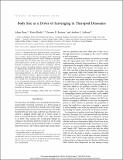Files in this item
Body size as a driver of scavenging in theropod dinosaurs
Item metadata
| dc.contributor.author | Kane, Adam | |
| dc.contributor.author | Healy, Kevin | |
| dc.contributor.author | Ruxton, Graeme D | |
| dc.contributor.author | Jackson, Andrew L | |
| dc.date.accessioned | 2017-04-12T23:34:13Z | |
| dc.date.available | 2017-04-12T23:34:13Z | |
| dc.date.issued | 2016-06 | |
| dc.identifier | 243025243 | |
| dc.identifier | cf096ef1-2fd5-4c5c-9838-b8bf93733722 | |
| dc.identifier | 84966727798 | |
| dc.identifier | 27172591 | |
| dc.identifier | 000376271400004 | |
| dc.identifier.citation | Kane , A , Healy , K , Ruxton , G D & Jackson , A L 2016 , ' Body size as a driver of scavenging in theropod dinosaurs ' , American Naturalist , vol. 187 , no. 6 , pp. 706-716 . https://doi.org/10.1086/686094 | en |
| dc.identifier.issn | 0003-0147 | |
| dc.identifier.other | ORCID: /0000-0002-3548-6253/work/38548539 | |
| dc.identifier.other | ORCID: /0000-0001-8943-6609/work/60427540 | |
| dc.identifier.uri | https://hdl.handle.net/10023/10617 | |
| dc.description | This work was funded by the Earth and Natural Sciences Doctoral Studies Programme and the Higher Education Authority through the Programme for Research at Third Level Institutions, Cycle 5 (PRTLI‐5), and cofunded by the European Regional Development Fund (K.H.) and Trinity College Dublin and the Irish Research Council (A.K.). | en |
| dc.description.abstract | Theropod dinosaurs dominated Earth’s terrestrial ecosystem as a diverse group of predators for more than 160 million years, yet little is known about their foraging ecology. Maintaining a balanced energy budget presented a major challenge for therapods, which ranged from the chicken-sized Microraptor up to the whale-sized Giganotosaurus, in the face of intense competition and the demands of ontogenetic growth. Facultative scavenging, a behavior present in almost all modern predators, may have been important in supplementing energetically expensive lifestyles. By using agentbased models based on the allometric relationship between size and foraging behaviors, we show that theropods between 27 and 1,044 kg would have gained a significant energetic advantage over individuals at both the small and large extremes of theropod body mass through their scavenging efficiency. These results were robust to rate of competition, primary productivity, and detection distance. Our models demonstrate the potential importance of facultative scavenging in theropods and the role of body size in defining its prevalence in Mesozoic terrestrial systems. | |
| dc.format.extent | 11 | |
| dc.format.extent | 1136611 | |
| dc.language.iso | eng | |
| dc.relation.ispartof | American Naturalist | en |
| dc.subject | Dinosaurs | en |
| dc.subject | Scavenging | en |
| dc.subject | Scaling | en |
| dc.subject | Body mass | en |
| dc.subject | Theropods | en |
| dc.subject | Agent-based model | en |
| dc.subject | QH301 Biology | en |
| dc.subject | Ecology, Evolution, Behavior and Systematics | en |
| dc.subject | DAS | en |
| dc.subject | SDG 15 - Life on Land | en |
| dc.subject.lcc | QH301 | en |
| dc.title | Body size as a driver of scavenging in theropod dinosaurs | en |
| dc.type | Journal article | en |
| dc.contributor.institution | University of St Andrews. School of Biology | en |
| dc.contributor.institution | University of St Andrews. Centre for Biological Diversity | en |
| dc.identifier.doi | 10.1086/686094 | |
| dc.description.status | Peer reviewed | en |
| dc.date.embargoedUntil | 2017-04-12 |
This item appears in the following Collection(s)
Items in the St Andrews Research Repository are protected by copyright, with all rights reserved, unless otherwise indicated.

